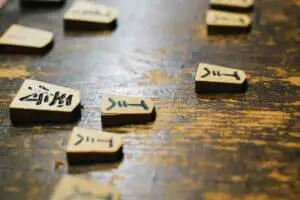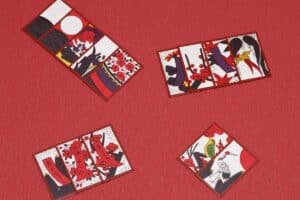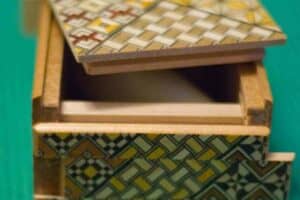As its name suggests, the puzzle box is a storage container which takes the completion of the puzzle to open it.
Also known as a ‘trick’, ‘mystery’, ‘enigma’, ‘impossible’, or ‘secret’ box, it is customary to hide something within it, which is then quite difficult to access.
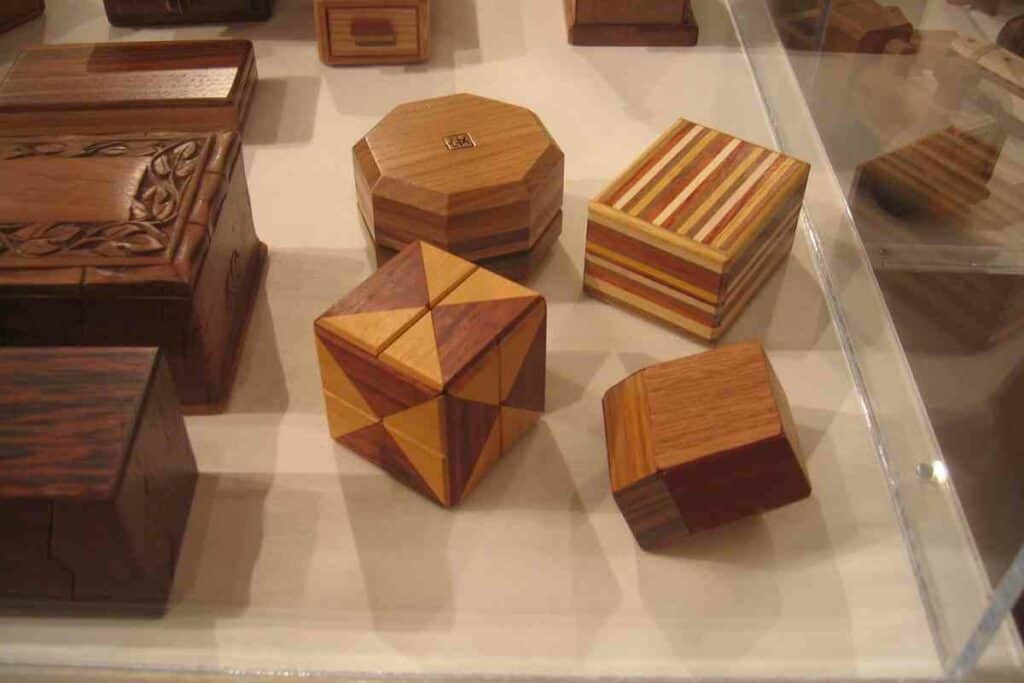
Raging in complexity, some boxes require multiple moves in a specific sequence, to get the lid open and so this has historically been utilised as a secure storage box.
[lasso type=”table” id=”74″ link_id=”8848″]
Reaching across different cultures, the puzzle box has been quite popular at certain points in History.
In This Article – We will take you on a journey through the entire history of the Japanese puzzle box, looking at the different styles and uses it has had and highlight the importance of this puzzling trinket to Japanese culture, as well as other cultures around the world.
Table of Contents
Where and when did the Puzzle Box originate?
The Japanese puzzle box is said to have first been created in a region of Japan known as Hakone, as early as the 19th century.
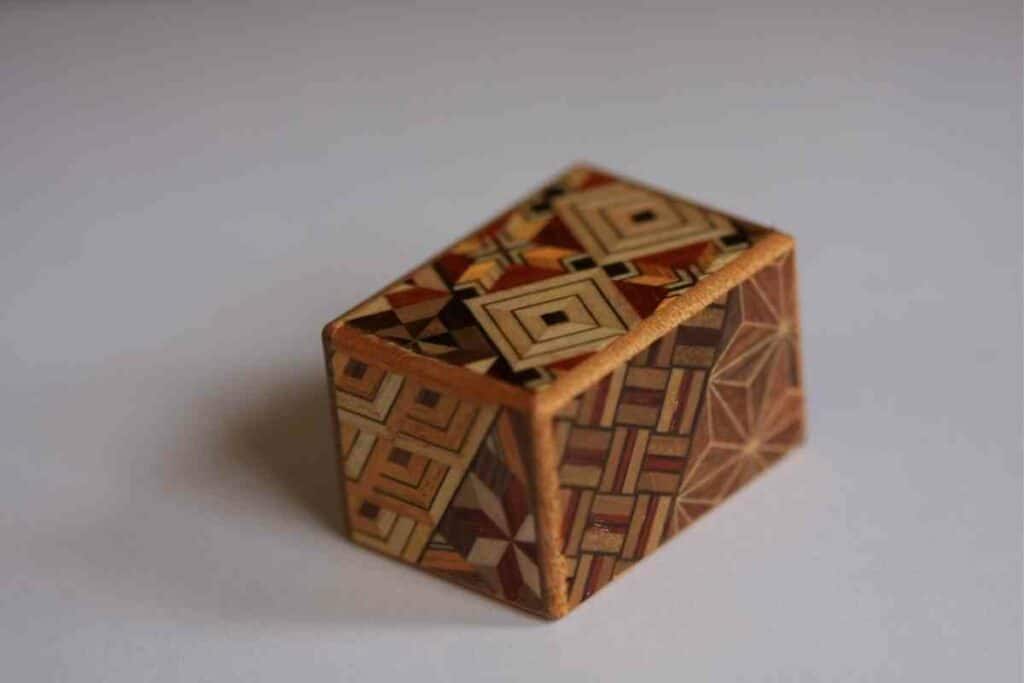
Combining a standard puzzle box with a Japanese puzzle known as Yosegi-zaiku, the introduction of Himitsu-bako is attributed to artisans:
- Okiyama
- Ohkawa
- and Kikukawa
This symbol of Japanese culture has featured as a prop in many fictional stories; most recently in the first season of Star Trek Picard (2021)– exclusive to Amazon Prime Video.
References to puzzle boxes have been found dating back thousands of years, according to some sources, and they have been a part of many different cultures for centuries.
With variations in many parts of the world, like England and Switzerland, their designs are also vastly varied.
What are puzzle boxes used for?
These secret storage boxes come in many sizes, styles, and designs.
Believed to have been established as a security measure, for the safe storage of tools, and other valuable items like jewelry and money, they were once used in Japan to keep children safe from small, dangerous items like sewing needles.
Additionally – They were used by the Samurai to transmit coded messages in times of war, but their uses are vast. In contemporary times, it is simply an intriguing form of entertainment, a pastime challenge for all ages.
As with the iconic Kokeshi doll, it was once a souvenir given to the visitors of Onsen and has evolved, greatly, over time.
Now, it is a decorative item as well which is also considered to be a collectable.
Also Read 📖
What do puzzle boxes look like?
Beginning as small, simply designed boxes with just 1 to 3 moves, the design has somewhat evolved since the Edo period (1868-1912).
Since the introduction of the Yosegi-zaiku, their designs have become much more intricate, with boxes housing puzzles that can take anywhere up to 100 moves to complete.
Record-breaking boxes have been created with over 1500 moves!
Most often and traditionally crafted from wood, by hand, these boxes make stunning ornaments.
Hakone is well-known for its plethora of different species of tree, so Himitsu-bako are made from a variety of woods.
As a Result – They are often unique and come in different shades and textures.
Geometric puzzle designs add an additional element of variation to them, often taking the form of iconic images of Japanese symbolism: Mt. Fuji often features, as well as airborne geese and other landscape scenes.
What is Yosegi-zaiku?
A kind of Marquetry which gained prominence, like many modern aspects of Japanese culture, in the Edo period, Yosegi-zaiku is an intricate artform which has been passed down through generations.
This artisanal addition to the emblematic Japanese puzzle box, made the way for many puzzle boxes which followed.
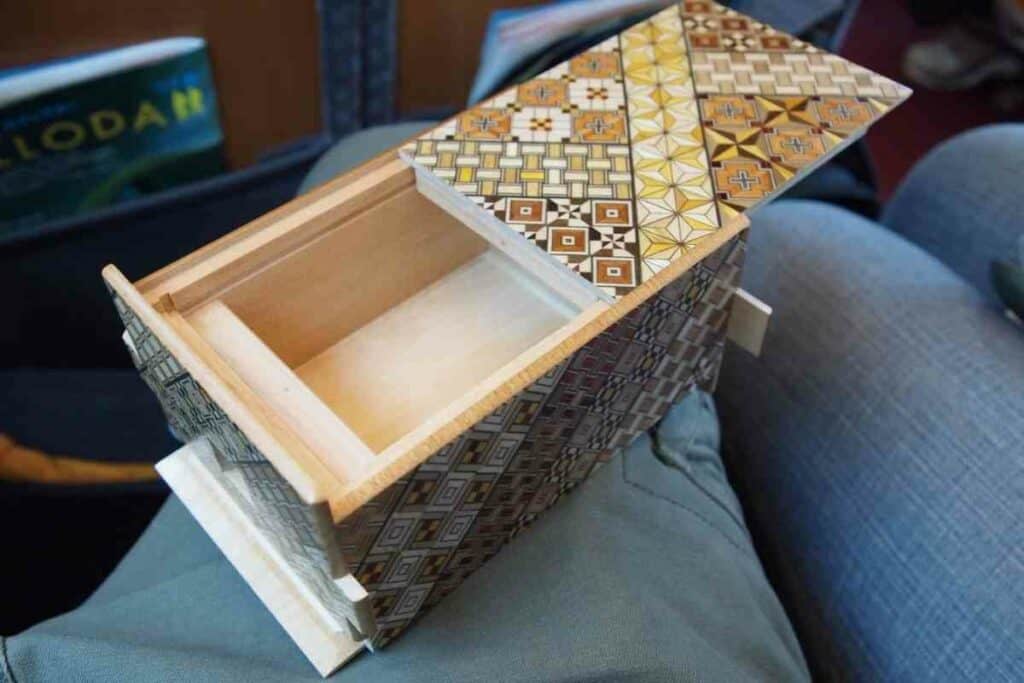
Nowadays, every box is made with similar designs and can be incredibly challenging to solve.
A form of mosaic, Yosegi-zaiku is created by aligning and gluing small sticks of wood together to form a geometric pattern, which often makes a complete image.
Some boxes are locked when the image is scrambled and repositioning the mosaic pieces unlocks them once the image is complete again.
Others are craftier and take specific sequential movements which exist among many possibilities and have almost driven people mad with frustration.
A hammer, being the tool eventually used to gain access.
What is Zougan-zaiku?
Images are incredibly challenging to create just from varied shades of wood.
As a result, the Japanese also use a technique of coloring wood which is traditional within the culture.
Zougan-zaiku is a process which requires some skill and through which the wood is soaked through, forming a deep and rich color.
Again, passed down from generation to generation, the skill has been preserved and those competent are limited in number.
For the Best Effects – The wood is initially bleached via weathering and color is placed around parts intended to be white. This creates a stark, visual contrast and dates back to the days of papyrus in the times of the ancient Egyptian Pharos – around three thousand years in the past.
How is a puzzle box made?
Apparently, with great difficulty. Creating one of these artistic masterpieces takes a high level of expertise, time, and effort.
Genuine himitsu-bako are usually handmade by one person, from beginning to finish and only the craftsman knows the exact sequence for gaining access to it.
Having chopped and dried out the wood, over a period of weeks, producing a box is a detailed process because resistance between moving parts has to be perfectly precise.
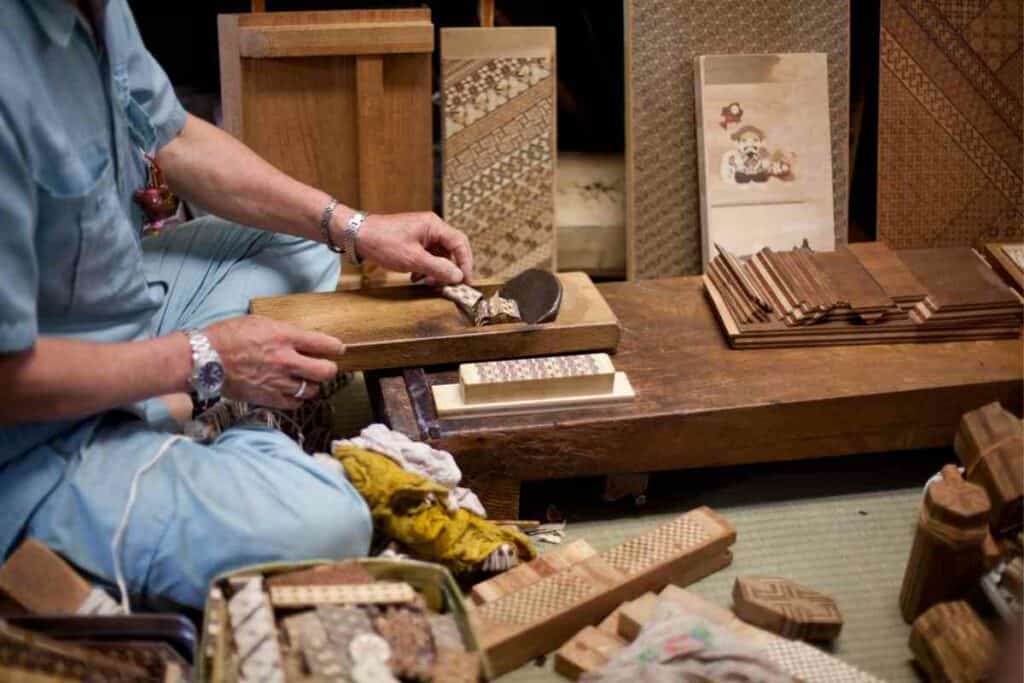
Not enough resistance will render the box practically useless, because the parts won’t secure into place in order to unlock the box effectively.
Likewise, too much resistance will make the pieces of the puzzle too difficult to move.
The craft is so niche, that in order to learn to make a traditional Japanese box, you would have to enlist the unique skills of an experienced master of the craft.
Although, it is true that you can teach yourself all kinds these days and there are plenty of web sources which claim to show you how.
How is a puzzle box solved?
Created as a covert hiding place for specific items, the unlocking mechanism is far from obvious when you look at one.
The idea is that they are so well-crafted and aesthetically pleasing that you wouldn’t even notice that there was a mechanism at all.
Unless it is clear from prior knowledge and experience or it is pointed out, you would simply admire its beauty.
The trinket inside would be totally safe, thanks to the art of disguise. Simple puzzle boxes can have just a single button to find within the pattern.
Press it and the box will open. Others are full of buttons, small, sliding panels and twisting parts.
The number of moves can range anywhere from one or two to literally hundreds, or even thousands, when people try to break records.
How big are Japanese puzzle boxes?
Ranging in size, the earliest boxes were very small.
The unit of measurement being one ‘sun’ (just around 3cm cubed). Most are rectangular and can be built up to any manageable size.
On average they can range from 1 to 5 suns and can be even larger than that.
Nowadays they are around 1 by 2 suns (6x3cm on the larger surfaces) and are usually built to fit in the palm of the hand.
What different variations of puzzle box exist?
As there is no limit to geometric patterns, the possibilities are literally boundless.
The Japanese puzzle box is massively varied and is still in production.
Some are so detailed that the top and bottom are the only faces without a puzzle present.
Others are patterned with such astonishing geometrics that they will play havoc with your eyes.
These detailed masterpieces of artwork can even have additional hidden drawers to the internal space.
In Fact: Some puzzle boxes have evolved as far as becoming miniature escape rooms and are even built with a number of layers and drawers, encompassing multiple puzzles to crack each section. Some are more complex to solve than a cryptex.
Famous Scientific Links in History
Not only has this famous trinket featured in famous movies and epic tales but it has also made a number of appearances within the theoretical and experimental sciences.
Probably the most prominent link to History, was the use of a puzzle box to establish the theoretical framework of ‘Law and Effect’ (1898).
Experimenting on cats, E. L. Thorndike invented a simple puzzle box with an inner release mechanism.
He placed food outside and a cat inside and waited to see if the cat was motivated enough to find its way out.
Similar to Erwin Schrodinger (1935), the use of a box was then replicated in the famous work of Skinner (1948), who devised one very similar one to Thorndike’s called the ‘Skinner Box’ and worked a lot with the more developed theory of ‘Cause and Effect’.
Is it a dying artform?
Being an artform which is passed down through generations, the traditional Japanese craft is confined to a small number of masters and could vanish completely in time.
The youngest traditionally trained craftsman is said to be in his sixties and unfortunately has no apprentice to carry on the trade.
Winner of the 1998 Woodworking Crafts Contest, Mr. Yoshikazu Goto (1935-) still produces his masterpieces to this day.
He may even be looking for an apprentice!
That being the case, the form itself will likely never be lost because they are produced all over the world. They sell, for example, all over the internet.
Where can I buy a real Japanese puzzle box?
The best place to purchase a genuine Japanese puzzle box is to visit Japan and plan a trip to the Hakone region.
There you will find master craftsmen from whom you can purchase one.
These marvels of artwork are, however, sold widely, and you can even purchase unique, handmade puzzle boxes on Etsy.
What to Expect? They range in price and can be very expensive. One, seemingly genuine Yosegi-zaiku puzzle box is even listed for over $700.00! But is a larger jewelry box and appears to be impeccably made.
Average boxes sell for around $40.00 and vary in price up to approximately $150.00, depending on design, size, and method of production.
Alternatively, there are plenty of cheap, run of the mill, fun versions which are still beautifully decorative items.
Amazon even have small, more reasonably priced, plain range which come in at less than $20.00 apiece.
Final Thoughts
One of many fascinating aspects of Japanese culture, the puzzle box is stunning artform which transcends time and location.
Present in many countries throughout the globe, it has evolved from a simple, small item, storage box to a worldwide masterpiece of varied design, usage, and entertainment.
Rivalling some of the most discombobulating puzzles ever made, Himitsu-bako are a challenge for all ages and can even keep your precious, personal items secure from thieves.
They were even trusted by the great Samurai themselves…



